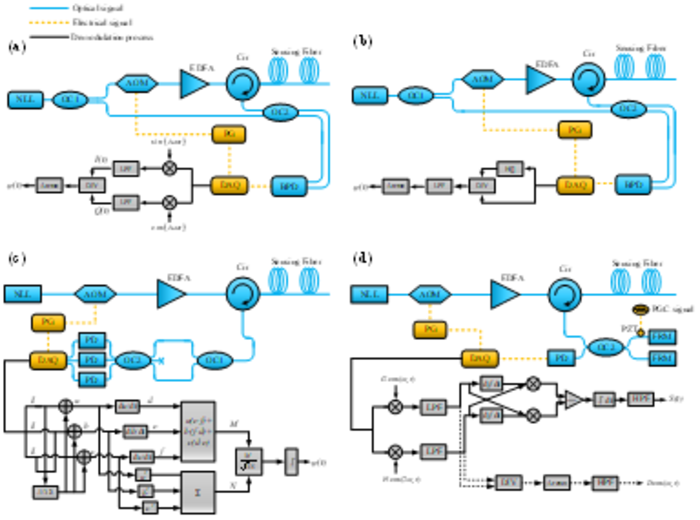Reviewed by Alex SmithApr 5 2022
A new Opto-Electronic Advances publication gives an insight into developments in distributed fiber optic vibration/acoustic sensing technology.
 The setup of DAS-Φ-OTDR systems with different demodulation methods. (a) heterodyne detection and I/Q phase demodulation; (b) heterodyne detection and Hilbert transform phase demodulation; (c) direct detection and phase demodulation based on 3×3 coupler; (d) direct detection and phase demodulation based on phase generated carrier algorithm. Image Credit: Opto-Electronic Advances.
The setup of DAS-Φ-OTDR systems with different demodulation methods. (a) heterodyne detection and I/Q phase demodulation; (b) heterodyne detection and Hilbert transform phase demodulation; (c) direct detection and phase demodulation based on 3×3 coupler; (d) direct detection and phase demodulation based on phase generated carrier algorithm. Image Credit: Opto-Electronic Advances.
The Rayleigh backscattered light generated by periodically incorporating laser pulses into the fiber under test (FUT) is used in distributed fiber optic vibration/acoustic sensing technology to accomplish long-range, high-spatial-resolution vibration identification along the entire length of the FUT.
In comparison to the traditional electrical or mechanical sensors, this technology works in a completely distributed manner with great sensitivity, remote accessibility and immunity to electromagnetic interference, making it ideal for a wide range of application prospects, particularly in harsh environments.
Since the introduction of the first fiber-optic distributed vibration sensing (DVS) system based on φ-OTDR in 2005, phase-sensitive optical time-domain reflectometry (φ-OTDR) technology has been rapidly growing. It gradually developed into distributed acoustic sensing (DAS) technology capable of quantitatively analyzing acoustic waveforms.
Studies have undertaken extensive research to improve the sensing performances of φ-OTDR systems, including key performance measures such as sensing distance, spatial resolution, frequency response variety and event recognition algorithms.
φ-OTDR has been widely used in engineering applications in recent years, particularly in the development of fields of seismic wave acquisition, oil and gas resource exploration, pipeline leakage detection, perimeter safety, cable partial discharge tracking and so on, due to its superior long-range and high-resolution dispersed sensing capability.
With the advancement of sensitivity-enhanced fiber optic cable, novel sensing mechanisms, effective signal processing processes and precise vibration event recognition algorithms in the coming years, φ-OTDR-based DVS/DAS will have a wide range of commercial implementations, which include distributed fiber shape sensing and geological exploration.
Eventually, this study described the future potential benefits and challenges of φ-OTDR-based DVS/DAS technology development.
Professor Liyang Shao’s research team from Southern University of Science and Technology in China and Professor Feng Wang’s research team from Nanjing University in China discussed the research improvements of φ-OTDR-based fiber optic DVS/DAS technology and its promising applications.
Firstly, the sensing fundamentals of the DVS-φ-OTDR system based on Rayleigh backscattered light intensity demodulation and the DAS-φ-OTDR system based on phase demodulation were investigated.
DAS phase demodulation methods were introduced and compared, including heterodyne detection schemes with I/Q demodulation, heterodyne detection schemes with Hilbert transform, direct detection schemes based on 3x3 coupler and direct detection schemes based on phase-generating carrier algorithm.
Finally, the performance enhancement methods for the key sensing parameters of φ-OTDR systems, such as maximum sensing distance, signal-to-noise ratio, vibration frequency response range, spatial resolution and vibration pattern recognition accuracy, were examined and summarized in detail.
This review also summarizes the engineering applications of φ-OTDR systems in various fields, including geological exploration, pipeline protection, perimeter security and cable partial discharge detection, as well as special applications like shape sensing, gas concentration sensing and pest infection recognition.
Journal Reference:
Liu, S., et al. (2022) Advances in phase-sensitive optical time-domain reflectometry. Opto-Electron Advances. doi.org/10.29026/oea.2022.200078.